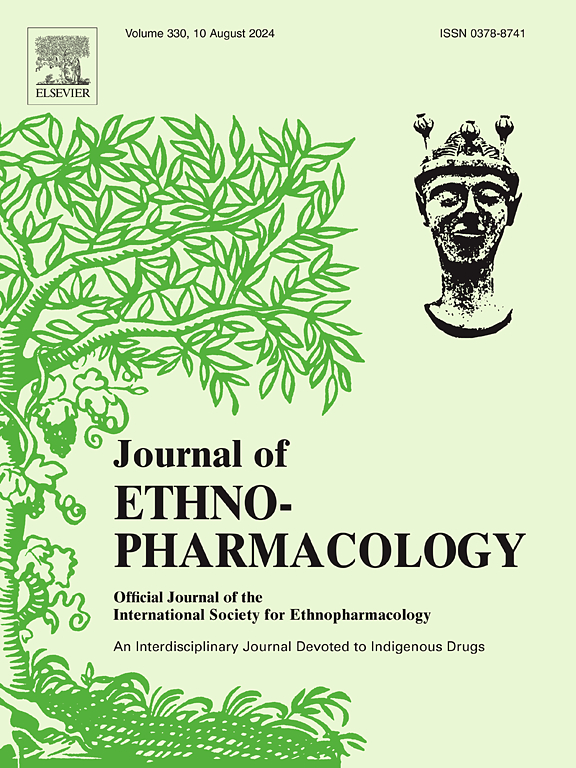亚慢性雄黄暴露通过下调回肠FXR诱导胆汁酸介导的NLRP3炎性体激活,导致小鼠肝脏炎症损伤
IF 5.4
2区 医学
Q1 CHEMISTRY, MEDICINAL
引用次数: 0
摘要
民族药理学意义海藻在现代医学和中医中都有广泛的应用。虽然雄黄有治疗用途,但它具有肝毒性,使用不当可导致肝脏炎症和损伤。在雄黄暴露小鼠的肝脏中,已经观察到胆汁酸(BA)稳态的破坏,被确定为肝损伤的初始事件。然而,雄黄诱导的BA稳态失衡与肝脏炎症的关系尚不清楚。目的探讨雄黄暴露引起小鼠肝脏BA稳态紊乱与肝脏炎症的关系,以及肠道法内甾体X受体(FXR)在雄黄诱导的肝脏炎症中的作用及其潜在机制。方法建立亚慢性雄黄暴露小鼠模型,并给予限肠FXR激动剂或抑制剂干预。用分光光度法测定血浆肝酶活性和总胆汁酸(TBA)水平。采用ELISA或RT-qPCR检测肝脏炎性细胞因子水平。采用HE染色对肝损伤进行组织病理学评价。免疫组化检测F4/80表达。Western blot (WB)和免疫组化(IHC)检测FXR-FGF15轴相关蛋白的表达,ELISA检测血浆FGF15浓度。WB检测肠肝循环相关蛋白及NLRP3炎性小体通路的表达。采用超高效液相色谱-飞行时间质谱(UPLC-TOF-MS)分析回肠和肝脏组织中的BA谱。结果雄黄暴露可引起小鼠回肠BA组成的改变,进而抑制FXR-FGF15信号轴。这种轴抑制促进了雄黄暴露小鼠肝脏BA的过量产生,破坏了肝脏BA的稳态,特别是提高了牛磺酸鹅脱氧胆酸(TCDCA)和牛磺酸石胆酸(TLCA)的水平。体外研究发现,TCDCA和TLCA均可直接激活AML-12细胞中的核苷酸结合寡聚结构域样受体家族pyrin结构域- 3 (NLRP3)炎性小体,引发促炎级联反应。药理激活肠道FXR可通过恢复BA稳态和抑制NLRP3炎性体激活,有效改善雄黄诱导的肝脏炎症损伤。结论雄黄暴露通过下调回肠FXR,诱导ba介导的NLRP3炎性体活化,引起肝脏炎症损伤。药理激活肠道FXR可通过恢复BA稳态和抑制BA介导的NLRP3炎性体激活来减轻雄黄诱导的肝脏炎症损伤。这些发现提示,肠道FXR可能作为预防和治疗雄黄诱导的肝损伤的潜在靶点。本文章由计算机程序翻译,如有差异,请以英文原文为准。

Sub-chronic realgar exposure causes liver inflammatory injury in mice by inducing bile acid-mediated NLRP3 inflammasome activation through down-regulation of ileal FXR
Ethnopharmacological relevance
Realgar is extensively utilized in both modern medicine and traditional Chinese medicine. Although it has therapeutic uses, realgar exhibits hepatotoxicity, and improper use can result in liver inflammation and injury. The disruption of bile acid (BA) homeostasis, identified as an initiating event in liver injury, has been observed in the livers of realgar-exposed mice. However, the relationship between realgar-induced BA homeostasis imbalance and liver inflammation remains to be elucidated.
Aim of the study
To investigate the relationship between hepatic BA homeostasis disorder and liver inflammation caused by realgar exposure in mice, as well as the role and potential mechanism of intestinal farnesoid X receptor (FXR) in realgar-induced liver inflammation.
Methods
A sub-chronic realgar exposure mouse model was established and subjected to interventions with an intestinal-restricted FXR agonist or inhibitor. Plasma hepatic enzyme activities and total bile acid (TBA) levels were quantified using spectrophotometry. Hepatic inflammatory cytokine levels were analyzed by ELISA or RT-qPCR. Histopathological evaluation of liver injury was performed using HE staining. F4/80 expression was assessed via immunohistochemistry (IHC). Western blot (WB) and IHC were employed to examine the expression of proteins involved in the FXR-FGF15 axis, and plasma FGF15 concentrations were determined by ELISA. The expression of proteins related to enterohepatic circulation and the NLRP3 inflammasome pathway were evaluated using WB. Ultra-performance liquid chromatography coupled with time-of-flight mass spectrometry (UPLC-TOF-MS) was utilized to analyze BA profiles in both ileal and hepatic tissues.
Results
Our findings demonstrate that realgar exposure induces changes in ileal BA composition and subsequent suppression of the FXR-FGF15 signaling axis in mice. This axis suppression promotes hepatic BA overproduction and disrupts BA homeostasis in the livers of realgar-exposed mice, particularly elevates the levels of taurochenodeoxycholic acid (TCDCA) and taurolithocholic acid (TLCA). In vitro studies revealed that both TCDCA and TLCA can directly activate the nucleotide-binding oligomerization domain-like receptor family pyrin domain-containing 3 (NLRP3) inflammasome in AML-12 cells, triggering pro-inflammatory cascades. Pharmacological activation of intestinal FXR effectively ameliorated realgar-induced hepatic inflammatory damage via restoring BA homeostasis and suppressing NLRP3 inflammasome activation.
Conclusion
Realgar exposure causes liver inflammatory injury by inducing BA-mediated NLRP3 inflammasome activation through down-regulating ileal FXR. Pharmacological activation of intestinal FXR alleviates realgar-induced liver inflammatory injury by restoring BA homeostasis and inhibiting BA-mediated NLRP3 inflammasome activation. These findings suggest that intestinal FXR may serve as a potential target for the prevention and treatment of realgar-induced liver injury.
求助全文
通过发布文献求助,成功后即可免费获取论文全文。
去求助
来源期刊

Journal of ethnopharmacology
医学-全科医学与补充医学
CiteScore
10.30
自引率
5.60%
发文量
967
审稿时长
77 days
期刊介绍:
The Journal of Ethnopharmacology is dedicated to the exchange of information and understandings about people''s use of plants, fungi, animals, microorganisms and minerals and their biological and pharmacological effects based on the principles established through international conventions. Early people confronted with illness and disease, discovered a wealth of useful therapeutic agents in the plant and animal kingdoms. The empirical knowledge of these medicinal substances and their toxic potential was passed on by oral tradition and sometimes recorded in herbals and other texts on materia medica. Many valuable drugs of today (e.g., atropine, ephedrine, tubocurarine, digoxin, reserpine) came into use through the study of indigenous remedies. Chemists continue to use plant-derived drugs (e.g., morphine, taxol, physostigmine, quinidine, emetine) as prototypes in their attempts to develop more effective and less toxic medicinals.
 求助内容:
求助内容: 应助结果提醒方式:
应助结果提醒方式:


